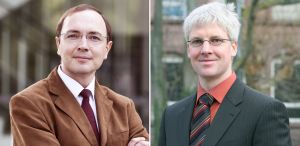How can data be transmitted more rapidly and energy-efficiently? This question is studied by a research group on terabit communication, which is headed by Professor Christian Koos from the Institute of Photonics and Quantum Electronics (IPQ) of KIT. PD Dr. Alexander Nesterov-Müller from the Institute of Microstructure Technology (IMT) works on a new process to produce highly dense peptide arrays – smallest “data carriers” with amino acids – for immunology and medicine development. Both scientists have now acquired one of the renowned ERC Starting Grants each.
Their projects will be funded with about EUR 1.5 million each over a period of five years. With the Starting Independent Researcher Grant, the European Research Council (ERC) funds pioneer projects of young scientists under the specific programme “Ideas” of the 7th EU Research Framework Programme. The 2011 Starting Grant is the fourth call for proposals. In 2009 and 2010 already were the KIT physicist Dr. Regina Hoffmann and the KIT climate researcher Dr. Matthias Schneider awarded this renowned grant. A total of 4080 proposals were submitted in 2011, about 450 of them can be funded in this round.
Worldwide data traffic is growing continuously and requires more and more energy. In 2007, information and communication technology was responsible for around 10% of electricity consumption in Germany. A large fraction was used for data transmission in computing centers, access and wide area networks. Making data transmission more rapid and more energy-efficient is the objective of the research group on “Energy-efficient terabit communication” that will be established by Professor Christian Koos with the ERC funds at the IPQ.
Using new transmission technologies, optical frequency combs, and nanophotonic components, the transmission rate in data networks is to be increased from presently 100 gigabits per second by a factor of 100 to more than 10 terabits per second. “This corresponds to about 1 billion telephone calls,” explains Professor Koos. For this purpose, optical frequency combs are applied, which consist of a regular pattern of frequency lines. Frequency combs may be used as an optical ruler to measure the frequency of electromagnetic radiation with highest precision. Together with nanophotonic components that combine a high number of nanostructures on a minute silicon chip, optical frequency combs allow for energy-efficient processing of data flows with high transmission rates on smallest space.
At the Institute of Microstructure Technology (IMT) of KIT, PD Dr. Alexander Nesterov-Müller is working on a new process to produce highly dense peptide arrays with the help of laser radiation under his ERC project. Peptides are chains of amino acids. With the help of the new method, they can be synthesized on various surfaces, such as glass object carriers or silicon disks. Such peptide arrays are used in life sciences, where specific binding with peptides is relevant. This particularly applies to research into proteins and their interactions in cells and organisms (proteome research), immunology, but also to diagnosis and the development of medical agents. “Highly dense peptide arrays among others serve to study antigene-antibody interactions. With them, complete read-out of the information stored in the human immune system may become possible,” explains Nesterov-Müller.
In the course of the new process developed in close cooperation with PD Dr. Frank Breitling, the amino acids that make up the peptides are applied with highest precision by defined melting of solid particles using laser radiation rather than in solution. In this way, highly dense peptide arrays of up to a million peptides per cm2 can be produced. In parallel, Dr. Alexander Nesterov-Müller works on implementing molecular search machines to develop with maximum efficiency molecules with the desired material properties based on these highly dense arrays. Such a molecular search machine might be applied in many areas of life and material sciences, for instance, in the development of biocatalysts.
Professor Christian Koos has been holding the Chair for Photonic Communication Technology at the Institute of Photonics and Quantum Electronics (IPQ) of KIT since 2010. He studied electrical engineering at Universität Karlsruhe (TH), was conferred his diploma in 2002, and completed his doctorate in 2007. From 2007 to 2008, he worked at the IPQ as a post-doc and conducted pioneer research into nanophotonic silicon-organic hybrid (SOH) components. From 2008 to 2010, he was responsible for technology radars for nanotechnology and measurement technology in the research division of Carl Zeiss AG. Today, research of Christian Koos focuses on nanophotonics and optical data transmission and measurement technology.
PD Dr. Alexander Nesterov-Müller has been working at the Institute of Microstructure Technology (IMT) and as a lecturer at the Department of Mechanical Engineering of KIT since 2010. From 1992 to 1998, he studied physics at the Lomonosov Moscow State University. From 1998 to 2000, he was employed as a scientist by the Institute on Laser and Information Technologies at Moscow/Shatura and moved to the Institute for Solid-state and Materials Research, Dresden, in 2001. From 2002 to 2003, he worked as a scientist at the Heinrich Hertz Institute for Communication Technology, Berlin. From 2003 to 2010, he was member of the working group “Chip-based Peptide Libraries“ at the German Cancer Research Center in Heidelberg. At Heidelberg University, Nesterov-Müller was conferred his doctorate and post-doctoral lecture qualification in 2006 and 2008, respectively. Presently, Dr. Alexander Nesterov-Müller is conducting research into the production and further development of particle-based highly dense molecular arrays and their application for evolutionary search machines.
In close partnership with society, KIT develops solutions for urgent challenges – from climate change, energy transition and sustainable use of natural resources to artificial intelligence, sovereignty and an aging population. As The University in the Helmholtz Association, KIT unites scientific excellence from insight to application-driven research under one roof – and is thus in a unique position to drive this transformation. As a University of Excellence, KIT offers its more than 10,000 employees and 22,800 students outstanding opportunities to shape a sustainable and resilient future. KIT – Science for Impact.

